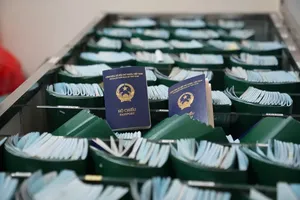
Green growth and sustainable development are inevitable trends and goals that all countries, including Vietnam – one of the nations most affected by climate change and environmental issues – are striving to achieve. However, as of early 2024, the outstanding balance of green credit is estimated at VND500 trillion (US$20.12 billion), accounting for only about 4.5 percent of the total outstanding bank credit. Compared to the set expectations, this figure is still quite modest.
Even with support from the government and ministries, in the 2017-2023 period, the outstanding balance of green credit in the banking system has merely grown at an average rate of about 22 percent per year.
Many credit institutions have developed green credit packages and programs suitable for their specific business operations and green transition; however, green lending and green development still face several barriers:
- No green classification list – a basis for the State Bank of Vietnam (SBV) to evaluate the effectiveness of solutions in credit policies contributing to achieving the national green growth target and for credit institutions to determine investment levels, scales, as well as appropriate banking policies, products, and services;
- Lack of a legal framework and policies related to the implementation of green finance and sustainable finance.
To overcome these obstacles, in August 2024, the SBV issued Decision 1663/2024 amending and supplementing a number of articles of Decision 1604/2018 of the Governor of the SBV approving the Green Banking Development Project in Vietnam.
In this decision, the SBV has added and adjusted a number of contents related to the development of green banking, green credit, and specific tasks of relevant organizations and units. That new decision is expected to create conditions for accessing green capital to develop green projects.
This is necessary and meaningful adjustments to enhance the sense of responsibility and proactiveness of the entire credit institution system in developing green credit, which is the starting point for implementing green credit activities, expanding and growing green credit of each credit institution.

Currently, an increasing number of credit institutions are implementing environmental and social risk management in lending activities and gradually approaching international standards in this activity. Therefore, the SBV's amendment and supplementation of specific and comprehensive regulations for the Green Banking Development Project is a vital step for the entire system to join forces in promoting sustainable financing activities.
The newly released decision has been warmly welcomed by several banks which are ready to lend to green projects and are eager to find suitable customers.
General Director Pham Nhu Anh of Military Bank shared that the proportion of green credit in his bank’s credit portfolio is high, at about 11 percent in 2023. It also focuses on building policies for diverse green products that meet the criteria of national green industry groups and are easily accessible to businesses. Due to a lack of applicable legal frameworks on the national green classification list for green credit, the bank is adopting the Environmental, Social, and Governance (ESG) standards to offer a lower loan rate by 0.5-2 percent to green businesses.
Similarly, the green trade finance portfolio of United Overseas Bank (UOB) Singapore across the region has reached $33 billion. Vietnam has 24 projects granted green credit by this bank. In April 2024, UOB Vietnam signed a green trade finance agreement with an agricultural business, Betrimex. To reach this cooperation agreement, Betrimex has passed UOB Vietnam's very strict green credit assessment process, one of which concerns solutions to reduce carbon emission by 14-16 percent.
“Finding the right projects for green development financing is not easy. In addition to businesses practicing ESG according to world standards, we will base our decisions on human factors, how businesses impact the environment, and whether or not they bring benefits to direct and indirect stakeholders,” said Lim Dyi Chang, Senior Director of Corporate Clients, UOB Vietnam.
Obviously, building and updating the green project list is one of the biggest obstacles for credit institutions in implementing green lending. Therefore, Decision 1663/2024 is critical to supplement the regulation "SBV periodically updates the green project list" and to set out specific responsibilities for the management agency:
- issuing guidance on green credit and environmental risk management;
- issuing guidance on building reports on green credit after relevant reports of the Government and ministries are released;
- building reference materials for credit institutions on green credit;
- managing environmental and social risks
Dr. Can Van Luc, Chief Economist at BIDV stated that to secure investment capital for green development, Vietnam needs to mobilize approximately $368-380 billion from now until 2040, equivalent to $20 billion per year.
Therefore, a perfected legal framework will create opportunities for the credit institution system to fully exploit its potential in the green sector. This includes proactively diversifying funding sources for the green sector and investing more deeply in designing specific green credit products and green bonds, rather than merely relying on the purpose of using capital and industries as guided by the SBV for classification.
Dr. Nguyen Tri Hieu, Banking and Finance Expert added that to overcome obstacles in providing credit for green projects, the SBV needs to issue clear regulations on the proportion of green credit in banks' credit portfolios. Specifically, each bank should allocate 10-20 percent of its credit portfolio to support environmental projects that meet green credit criteria. This regulation will force banks to arrange capital and find projects that meet the criteria.
In addition, it is necessary to develop the green bond market. Banks and large enterprises can participate in issuing and trading green bonds. Government guarantees are also crucial to promote the development of this type of bond. Finally, banks need to comply with the SBV's regulations and actively participate in promoting green credit. This requires a specific roadmap and commitment from all stakeholders.












)

)









